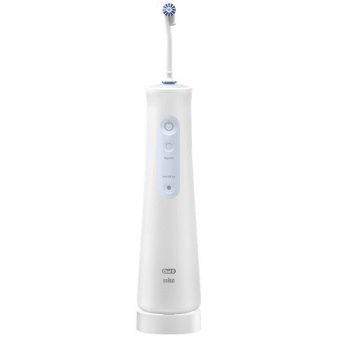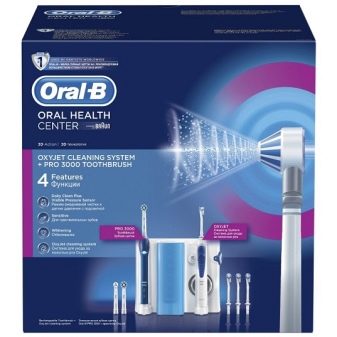All About Oral-B Irrigators

An oral irrigator (also called a water flosser) is a simple device that can be used at home. It is intended for quality care of teeth and gums.... Applying an irrigator several times a week after using a toothbrush removes food debris and plaque and helps whiten teeth.



Peculiarities
The very first irrigator was designed by a dentist in the second half of the 20th century. Since that time, the device has been constantly improved and modified to achieve the best effect and maximum ease of use. Irrigators are now electrically driven devices that power the pump. The device also has a water tank and a specially designed nozzle designed to supply a jet of water. Thanks to the electric drive, the pump starts to work, as a result of which, under pressure, water is supplied from the container through the nozzle. Cleaning the oral cavity with water pulsating under pressure helps to get rid of plaque, strengthen the gums, and remove food debris stuck between teeth or braces.
The Oral-B line of irrigators is represented by a large number of models. This is a modern high-quality technology that has a variety of functions that are tailored to the customer. Each consumer will be able to choose the most suitable option for himself.
Most Braun models provide the ability to adjust the water pressure, which is very convenient, because you can provide quality cleaning without harming sensitive teeth or gums.



Indications and contraindications
Any problem is easier to solve before it reaches a significant size. Therefore, everyone can use the irrigator, including people who do not have any problems with their teeth or gums.But there are several situations when the use of an irrigator for the oral cavity is already required due to its unsatisfactory condition, and the dentist strongly recommends purchasing this device for better cleaning of teeth at home.
Among such problems are the following.
- Thinned tooth enamel, which causes hypersensitivity in humans. Food and drink that is too cold or hot can cause very unpleasant sensations and even pain.
- The presence of braces, crowns, veneers, implants, dental bridges... When such designs were used for teeth, the issue of oral hygiene became paramount. Cleaning with a modern irrigator will help to solve it successfully in a short time.
- Bleeding gums can be caused by a variety of reasons., but using a water flosser will help solve this problem as well. Antiseptic solutions or decoctions of medicinal plants can be poured directly into a container of water, and massage with a jet under pressure will strengthen the gums.
- Bad breath can occur due to food debris between the teeth and inadequate brushing. An irrigator can easily remedy this situation.
- Prevention of diseases such as caries, periodontal disease, gingivitis.
A consultation with a dentist will help determine if a person has any contraindications for using an irrigator. Contraindications include the following: the presence of acute gum infections and oral injuries, recent surgery on the gums. It is also not recommended to use flosser for vascular rosacea.



Model overview
Irrigator manufacturers strive to provide consumers with maximum comfort when using the device. Therefore, there are various models to choose from.
- Portable irrigators can be battery-powered or cordless... These are very compact devices, easy to use. A certain disadvantage is insignificant power.

- Stationary flossers have more power. But they are rather bulky in size. Such models are located in the bathroom and are powered from an outlet.

- Flow irrigators can be attached to a shower head or to a tap. They do not require a battery or plug to operate, nor do you have to worry about filling the tank with water. The disadvantages include insufficient maneuverability and some inconvenience during operation.

An important function is the ability to regulate the pressure of the water jet... There are options with a rotating or pulsating jet, with a choice of the preferred number of pulsations. Also, the devices differ in the number and shape of the attachments. Today the choice of flossers for oral hygiene is quite wide. The models differ in type, configuration and cost.
Before purchasing an irrigator, it is necessary to compare the specifications, prices and recommendations of the dentist.


Oral-B Professional Care OxyJet MD20
The model is stationary irrigator with special fasteners that allows you to fix the device on the wall... This is a family flosser as it comes with 4 individual nozzles (for jet cleaning) and an ample water tank (600 ml). The device operates according to microbubble technology, the time of its uninterrupted operation is 15 minutes. Cooling time is approximately 2 hours. The device is powered from the electrical network; there is a switch on the handle. The device can operate in two modes: mono stream and turbo stream. The water jet pressure is infinitely adjustable.


Oral-B Aquacare 4 Pro-Expert MDH20.016.2
A portable device designed for blast cleaning... In the process of work, microbubble technology is used, due to which the water is enriched with microbubbles. The pressure is regulated in steps. Cleaning can be carried out in two modes: normal and weak.And there is a choice of stream: mono or turbo. The set includes one nozzle, a charger and a reservoir with a capacity of 145 ml, the switch is located on the handle of the device. The model is powered by a battery, there are no awkward cords.


Oral-B (Professional Care 3000 + Oxyjet MD20) OC20.535.3X
This model is a dental center, which includes 3 replaceable attachments (two attachments are designed for cleaning plaque, one is used for orthodontic structures), a liquid reservoir with a capacity of 600 ml, and a container for convenient storage of attachments. The device is equipped with an air filter and a water jet pressure regulator. There is a charge level indicator in the handle, which allows you to charge the device on time. Very user-friendly is the backlit visual pressure sensor. This sensor starts to glow red if the person who uses the device presses too much water on the teeth.
This model also provides two flow modes: mono and turbo. The device can function in four modes: daily cleaning, whitening, sensitive, irrigator. The recommended cleaning time is at least 2 minutes. A special timer built into the device will allow you to control the time of exposure to the oral cavity. Each of the presented models allows you to make hygienic cleaning of teeth and gums of higher quality. Which one to choose depends on the needs of a particular buyer.


Equipment
Currently, devices are produced with different types of attachments. This can be a single-jet nozzle designed to remove food debris or a multi-jet nozzle that is used to perform massage. For people who wear braces, the use of a special otrodontic tip is recommended... A fine rubber tip (periodontal) is used for cleaning pockets.
To clean bridges, implants, crowns, a brush head is preferred. Some models may offer other types of irrigator tips. The complete set of devices depends on the manufacturer. But there is always the opportunity to purchase spare parts that may be required during operation.
The most popular spare parts for water flossers are chargers for portable models, replaceable water tanks, handles and hoses, nozzle containers.


User manual
The irrigator can be used every day or two to three times a week, depending on the condition of the oral cavity. It is best to do this after brushing with a toothbrush. When using for the first time or if the gums are sensitive, set a low water jet pressure. This is to avoid damaging the gums. Subsequently, the speed can be increased. Water is directed from the gums to the tooth to remove plaque. Further, to remove deposits, a stream of water is directed to the gingival pockets. Some models provide a choice of different modes: cleaning or massage. The oral cavity treatment procedure takes 3-5 minutes.
After use, the flosser needs to be rinsed with hot water and dried. This prevents the formation and build-up of limescale. It is also recommended to periodically disinfect the device in order to prevent the growth of viruses, microbes and various bacteria in the nozzle or in the hose. The water tank must be rinsed with hot water; a dishwasher can be used for this.
An oral irrigator is not a substitute for a toothbrush or floss. However, it is an excellent addition to ensure oral hygiene and cleanliness.












